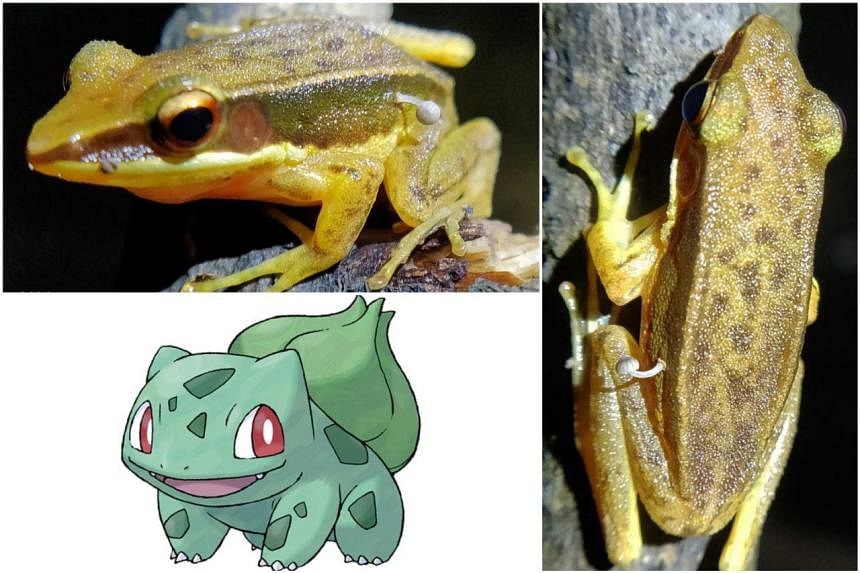You may have heard of Bulbasaur, a frog-like amphibian Pokemon with a plant growing on its back.
Well, this story is not about the best starter Pokemon of all time, but it comes close enough – a frog with a mushroom sprouting from its body has been discovered in India.
“While fungi have been observed to grow in odd places before, this is the first time a mushroom has been seen sprouting on living animal tissue,” said World Wide Fund for Nature-India (WWF-India) in a Facebook post on Feb 13.
Mr Lohit Y.T, a wetlands specialist with the conservation organisation, and amateur naturalist Chinmay Maliye were searching for amphibians and reptiles in the foothills of the Kudremukha Ranges in Karnataka in June 2023, when they found the frog. Karnataka is an Indian state about 1,900km south of the capital New Delhi.
In their co-authored note, published in the January issue of Reptiles & Amphibians, an international journal of peer-reviewed research in all aspects of herpetology or the study of amphibians, the duo said they encountered about 40 Rao’s Intermediate Golden-backed frogs (Hylarana intermedia) in a small roadside pond.
They observed an individual specimen perched on a twig with a “distinct outgrowth” on its left flank.
Upon closer observation, a mushroom – later identified as a species of bonnet mushroom – could be seen sprouting from its skin. Bonnet mushrooms obtain nourishment from decaying organic material and are normally found on rotting wood.
“To the best of our knowledge, never has a mushroom sprouting from the flank of a live frog been documented,” they wrote.
Mr Lohit also responded to a comment on the WWF-India Facebook post asking if the frog and mushroom were symbiotic – where two dissimilar organisms share a relationship or interaction. He noted that a relationship between the frog and the mushroom is not known and “further studies need to be done to explore it”.
The duo could not bring back the frog, so a prognosis could not be made.
“This is truly remarkable,” New Mexico Consortium research scientist Nancy Karraker of the Centre for Applied Fire and Ecosystem Science told Forbes.
“The closest I have gotten is finding ticks on frogs in Panama and seeing a juvenile red-backed salamander inside of the hollow stipe of a mushroom, presumably hunting insects.”
However, as bonnet mushrooms are a broad category with hundreds of species, Ms Karraker said that it would be hard to understand what was happening without knowing the exact species of mushroom, as some feed on live wood, some on rotting wood, some on animal dung, some on decaying leaf litter.
“But none of these things relate to the flank of a live frog,” she said.
Ms Karraker speculated that the frog might have a skin condition or injury with organic matter embedded in it that provided the mushroom spore an anchor for growth.
Thomas Horton, a mycologist, or someone who studies fungi, told Forbes he would expect to see skin discolouration or fluffy white filaments from the fungus if the mushroom was causing a skin disease, but the frog’s skin does not appear to show obvious signs of distress.
“As it is, it may just be a case of the little mushroom finding a foothold and making a mushroom,” he said. “Fungi will do that on rocks.”
Another mycologist, Dr Christoffer Bugge Harder from the University of Copenhagen, said the discovery was surprising.
“I would guess that this is a purely superficial skin infection with Mycena (a type of mushroom),” Dr Harder said. “Those can be sustained over a long time, as most fungal skin infections in humans.”
The mushroom-sprouting frog is not the first animal to resemble, or be named after, a Pokemon.
The multi-billion-dollar Pokemon franchise has left its mark on the world of science, with several real-world creatures named after the fictional critters after they were newly discovered.
A new cockroach species found in Singapore was named after Pheromosa, a cockroach-like Pokemon that appears in the video game series.
Also, three new species of Australian beetles – identified by their fiery colours – were named in 2021 after legendary birds Articuno, Zapdos and Moltres; a wasp was named after the bug Pokemon Weedle, while a bee species was called Chilicola charizard after the fan favourite.


